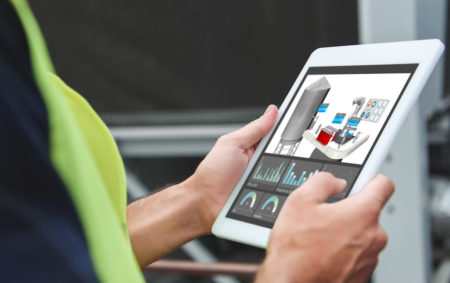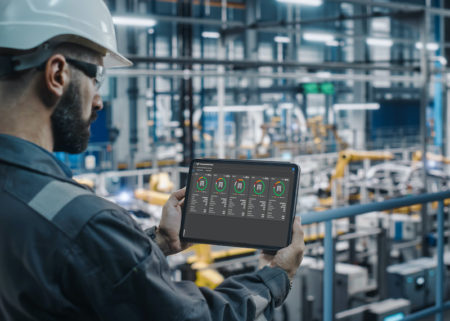SPONSORED BY: ICONICS
Today’s leading industrial trend is that of cloud analytics with edge connectivity to plant floor data, a common Industry 4.0 architecture to enable digital transformation. Industry 4.0 goes by different names in different markets: Germany – Industrie 4.0; USA – Smart Manufacturing; China – Made in China 2025; Korea -Fourth Revolution; and Japan – Society 5.0, to name a few. Regardless of the market or application, it is clearly recognized that today is the age when technology should unleash innovation as never before. However, now more and more analysts are recognizing that while the potential of Industry 4.0 is real, without the proper technologies, the execution is challenging and the barrier to entry can be high. While large corporations are equipped to fund and implement Industry 4.0 solutions, the promise of innovation remains out of reach for small and medium enterprises (SMEs), the ones that have limited budgets and that are challenged with the time and staff needed for these implementations. Yet SMEs make up over 99% of manufacturing (U.S. Bureau of the Census, Statistics of U.S. Businesses), and given this fact, the introduction of innovation at the SME level would dramatically improve energy utilization, product quality, productivity, and overall competitiveness throughout all of industry.
So how do we unleash this new level of innovation? According to CESMII, the USA Government Institute to promote Smart Manufacturing, the key is in standardizing access to data; standardization to the point that applications can be pre-built to recognize and use the information from an organization’s processes. This new level of Plug and Play will be ushered in through the existence of crowd-sourced information models, supported by communications that deliver the appropriate connectivity and context. Such communication solutions will include OPC UA, MQTT, and CC-Link, among others. Subsequently, the task for process engineers and system integrators will not be the creation of new and unique names for data registers and connections for equipment and processes, but the selection of communication solutions that automatically present standardized information models. These models will be accompanied by pre-built applications that will take advantage of these solutions. For example, CESMII and others will deliver marketplaces for the exchange of information models and directories of supporting applications. To promote this technology, the OPC Foundation is managing a Cloud Library Working Group and defining the Information Model file formats.
As a result, information model standardization is gaining global support. In addition to global partnerships that have been announced to support the CESMII initiative, there are activities underway to develop a wide variety of standard information models for market adoption. These initiatives are supported by the OPC Foundation through OPC UA collaborations and Companion Specifications, for example VDMA, PackML, and MTConnect, to name a few.
Therefore, when seeking a competitive advantage, there is a need to collaborate, to determine the available technology and approaches, and to identify companies that have the products and expertise that would be beneficial to any digital transformation journey. One such company is ICONICS.
ICONICS, a group company of Mitsubishi Electric Corporation, is a domain leader in key vertical markets, supporting the latest technologies and open industrial standards. As a member of the OPC Foundation since its early days, ICONICS has held a position on the OPC Foundation Board of Directors since 2003. ICONICS has collaborated with industry giants like Microsoft and is both a supplier of advanced building automation solutions, as well as a key industry technology partner, delivering leading solutions based on Microsoft’s latest technologies such as mobile platforms and cloud-based analytics. Moreover, ICONICS can be considered as a bellwether to coming technologies and trends, and being a Mitsubishi company, is a player to keep track of for current and coming trends. As a 100-year-old company with a substantial and impressive history in technological innovation, Mitsubishi has led the charge in Industry 4.0 and digital transformation technology well before it became vogue. Back in 2003, Mitsubishi called this technology e-F@ctory and stressed the need for Kaizen – Continuous Improvement through the communications connection of everything within the manufacturing enterprise, and later, the cloud. To assist with connectivity, Mitsubishi Electric was at the forefront of the adoption of open standards such as OPC Foundation technologies as well as the delivery of its own architectures for connectivity CC-Link, approved as an internationally recognized standard.
CC-Link represents a family of communications solutions that are designed for purpose in industrial automation. Using an open protocol, Seamless Message Protocol – SLMP, for both synchronous and asynchronous communications, CC-Link is an excellent and proven choice over a company inventing its own solution. SLMP is delivered over a twisted pair, fiber optic, standard Ethernet, Ethernet with deterministic token passing, and now, Ethernet for Time-Sensitive Networking (TSN). Mitsubishi Electric helped to establish the CLPA as a third-party organization to promote the adoption of CC-Link technologies. As one of the world’s leading automation suppliers, Mitsubishi Electric offers third-party vendors with products that are CC-Link compliant, a large potential market and an extensive array of distributors and system integrators to cultivate as partners.
Clearly, a partner of these three (Mitsubishi Electric Corporation, ICONICS, and CLPA) the OPC Foundation is a key resource to knowing the latest on Industry 4.0 and digital transformation technologies and industrial automation connectivity, and is thus key to success and networking in these areas.
Below are some important links to further your knowledge on some of the topics covered in this article:
- The Mitsubishi Electric Automation ecosystem: e-F@ctory Alliance Program
- The CC-Link Partner Association
- The CLPA Twitter Account and the CLPA Corporate LinkedIn page.
- The CESMII Twitter Account and CESMII Corporate LinkedIn page.
- The OPC Foundation Twitter Account and OPC Foundation Corporate LinkedIn Page
